The ‘72 Names of God’
[click this text to enlarge in a new and extremely wide window]
The unmarked text of Exodus XIV: 19, 20 & 2. Note that vowel marking did not exist prior to 700 C.E./A.D. (± 200).[2] o:O:o
Exodus XIV
19: And the angel of God, who went before the camp of Israel, removed and went behind them; and the pillar of cloud removed from before them, and stood behind them;
20: and it came between the camp of Egypt and the camp of Israel; and there was the cloud, and darkness here, yet gave it light by the night there; and the one came not near the other all the night.
21: And Moses stretched out his hand over the sea; and the Lord caused the sea to go back by a strong east wind all the night, and made the sea dry land, and the waters were divided.
The ‘72 names of God’ as revealed in Exodus 14: 19,20,21
[click the image to enlarge in a new window. click here for a printable .pdf file]
“When I came to the night in which this power was conferred on me, and midnight — when this power especially expands and gains strength whereas the body weakens had passed, I set out to take up the Great Name of God, consisting of seventy-two names, permuting and combining it. But when I had done this for a little while, behold, the letters took on in my eyes the shape of great mountains, strong trembling seized me and I could summon no strength, my hair stood on end, and it was as if I were not in this world. At once I fell down, for I no longer felt the least strength in any of my limbs. And behold, something resembling speech emerged from my heart and came to my lips and forced them to move. I thought—perhaps this is, God forbid, a spirit of madness that has entered into me? But behold, I saw it uttering wisdom. I said: ‘This is indeed the spirit of wisdom.’”
| Methods of Derivation The Jewish mystical tradition had two primary groups that were interested in esoteric meanings of the Hebrew Names of God:
Many alternate Names of God were derived through various methodical formulas applied to Biblical verses and already existing Names of God. These methods include:
| ||||||||||
| Mystical Hebrew Names of God | ||||||||||
| Monogrammata | ||||||||||
| The letter Hey ( | ||||||||||
| According to the Jewish mystics, Hey represents the divine breath or revelation. On the fifth day, the LORD created Light, and this corresponds to the letter Hey. Since the numerical value of Hey is five, this corresponds on a physical level to the five fingers, the five senses, and the five dimensions. On a spiritual level it corresponds to the five levels of soul: | ||||||||||
| ||||||||||
| “By the word of the LORD were the heavens made; and all the host of them by the breath of his mouth” (Psalm 33:6). In the Talmud (Menachot 29b) it is said that the “breath of His mouth” refers to the sound of the letter Hey - the outbreathing of Spirit. | ||||||||||
| The letter Aleph is the “father” of the Aleph-Bet, whose original pictograph represents an ox, strength, and leader. It’s numerical value is one (and also 1,000) and it is a silent letter. Aleph therefore is preeminent in its order and alludes to the ineffable mysteries of the oneness of God. Indeed, the word aluph (derived from the very name of this letter) means “Master” or “Lord.”
In the classical Hebrew script (ketav Ashurit) used for writing Torah scrolls, Aleph is constructed with two Yods (one to the upper right and the other to the lower left) that are joined by a diagonal Vav. Ketav Ashurit was the script that Jesus would have read (ketav Ivri was an older script, similar to ancient Phoenician, but was not the script used when Moses received the Torah from the LORD on Sinai. Ketav Ivri is also sometimes called the Temple Script because samples of it are extant dated to the time of Solomon’s Temple).
The basic gematria for the letter Aleph is one, indicating the One and only God who is the Master of the universe. Note, however, that the gematria for the parts of the letter Aleph add up to 26 (Yod+Yod+Vav). This is the same number as the sacred Name YHVH, also indicating a link between the Aleph and God Himself. This is also demonstrated in Exodus 3:14-15, where the LORD reveals His Name (I AM THAT I AM) | ||||||||||
| Digrammata | ||||||||||
| “Digrammaton” means “two letters” and refers to a two-letter Name of God. In the Scriptures, there are two main digrammata:
The Name |
| The Tetragrammaton |
| In the Tanakh, YHVH is the personal name of God and his most frequent designation, occurring over 5,200 times. This is the Ineffable Name or Unutterable Name of the God of Israel. Because it is composed from the four Hebrew letters Yod, Hey, Vav, and Hey, it is also referred to as the “Tetragrammaton,” which simply means “the four letters.” Kabbalists use the Name (and permutations of it) in their meditations. |
| Though we do not know how to pronounce the sacred Name, we can be confident that the letters | |||
| The Octagrammaton | |||
| “Octagrammaton” means “eight letters” and refers to an eight-letter Name of God created by interspersing the letters for Adonai with the letters for the Tetragrammaton: |
|
| ||||||||||||||||||||||||||||||||||||||||||||||||||||||||||||||||||||||||||||||||||||||||
| There are two forms of this Name. The first form of the twelve letter Name is simply YHVH three times: YHVH YHVH YHVH: |
| This comes from the prayer liturgy: Adonai Melech, Adonai Malchah, Adonai Yimlokh L’Olam Va’ed – “YHVH is King, YHVH was King, YHVH will be King forever and ever.” A second form of the 12-letter Name consists of the initials of the twelve tribes of Israel. These are recited in reverse order according to the breastplate of the Urim and Thumim: Reuven, Shimeon, Levi, Yehudah, Issachar, Zevulon, Dan, Naftali, Gad, Asher, Yosef, and Benyamin: | ||||||||||||||||||
| The Fourteen Letter Name of God | ||||||||||||||||||
| The Fourteen Letter Name was derived from the phrase Adonai Eloheinu Adonai from the Shema, and was sometime written on the backs of mezuzot. The Name is formed by the simple method of substitution known as At Bash: | ||||||||||||||||||
| The 22 Letter Name of God | ||||||||||||||||||
| The 22 Letter Name is sometimes considered part of the 72 Letter Name (see below) that includes reference to the 12 tribes of Israel (considered as Jeshurun): | ||||||||||||||||||
| Avraham, Yitzhak, and Yaakov, the tribes of Yeshurun (i.e., the upright). | ||||||||||||||||||
| The 33 Letter Name of God | ||||||||||||||||||
| This Name is derived from the Torah and is comprised of nine Names of God run together: Adonai, El, Eloah, Elohim, Shaddai, Tzeva’ot, Ehyeh, Yah, and YHVH: | ||||||||||||||||||
| The 42 Letter Name of God | ||||||||||||||||||
| The 42-Letter Name (like many of the others) has no known pronunciation, and perhaps was derived from the 2nd-century prayer “Ana Bekoach.” It is mentioned in the Talmud and many of the Jewish Sages have speculated about its significance: | ||||||||||||||||||
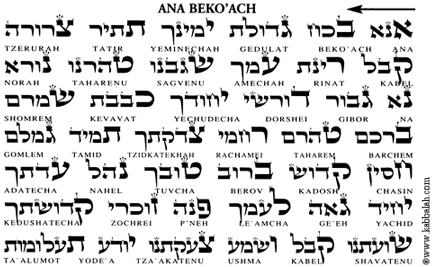 | ||||||||||||||||||
| The 72 Names of God - (or the 216 Letter Name of God) | ||||||||||||||||||
| The 216-Letter Name of God is really a 72-part Name, since it is a sequence of 72 triads of letters all of which are derived from permutations on Exodus 14:19-21 (which itself is composed of three verses of 72 letters each). To create the first triad, you put together the first letter of verse 14:19, the last letter of verse 14:20, and then the first letter of 14:21. To create the next triad, you put together the second letter of 14:19, the second to last of 14:20, and the second letter of 14:21. This continues until all the letters are used up. Like so: | ||||||||||||||||||
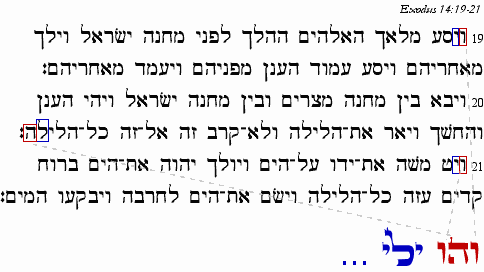 | ||||||||||||||||||
| Using the algorithm, you will find the following 72 triads of letters embedded in Exodus 14:19-21: | ||||||||||||||||||
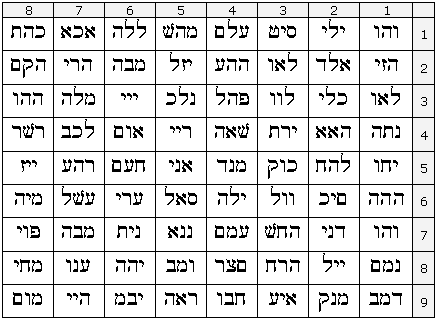 | ||||||||||||||||||
| Theoretical Kabbalists will look at each of the 72 triads and consider them as one of the 72 Names of God. They will perform various forms of gematria and other analysis of these names in order to elicit spiritual insight and transformation (this is sort of thing that Yehuda Berg does in his book, The 72 Names of God, Technology for the Soul). Practical Kabbalists create amulets using the 216 Letter Name. The Name is divided into two groups of thirty-six which the scribe writes on two amulets. One amulet is worn on one arm and the other on the other arm. |
| The 304,805 Letter Name of God | ||||
| What is the “best” Hebrew Name of God? Some of the Jewish sages have said that it is revealed by reciting all 304,805 letters of the Torah in a series. That is, string together all 304,805 letters of the Torah - from the first letter of Bereshit (Bet) through the last letter of Devarim (Lamed) - and “read” this as a single “Word.” There you have it!
| ||||



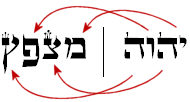



 Obviously this “Name” of God is intended to humble us and to remind us that God Himself is Ein Sof - without End or limitation of any kind. God is always greater than our greatest thoughts about Him, even if we attempt to express His transcendence by means of the sacred letters of the Torah.
Abba
Taking a different approach, we learn from the teachings of Yeshua the Mashiach that the Name of God is best understood as “Father.” In fact, Yeshua used the common Aramaic word for “daddy” (abba) to refer to His relationship with God, and He wanted his talmidim (disciples) to do likewise.
Obviously this “Name” of God is intended to humble us and to remind us that God Himself is Ein Sof - without End or limitation of any kind. God is always greater than our greatest thoughts about Him, even if we attempt to express His transcendence by means of the sacred letters of the Torah.
Abba
Taking a different approach, we learn from the teachings of Yeshua the Mashiach that the Name of God is best understood as “Father.” In fact, Yeshua used the common Aramaic word for “daddy” (abba) to refer to His relationship with God, and He wanted his talmidim (disciples) to do likewise. 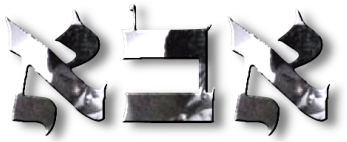

!["Brand of Humor" [sic]](http://3.bp.blogspot.com/_bwZgQyGykbY/RyZ2Ni7wZsI/AAAAAAAAAAM/jYQKkIejin0/s1600/NonSeq+holocaust+tattoo.jpg)